UnionTest / KORAD UT3005EP Laboratory Programmable Linear Power Supply & Calibration / Control
I recently bought the UnionTest UT3005EP laboratory power supply unit (31V 5.1A), which is another name for the well-known KORAD power supply unit, a purebred Chinese. Again, the original Chinese development, and not an unfinished copy. The first revisions of the blocks of this series (~ 2012) had flaws (in particular, at the maximum current - the power transistors could overheat, this was found in the eevblog video blog), but later they were corrected. Personally, I have a weakness for 4-bit LED indicators - that is why my choice fell on UnionTest / KORAD power supplies, given that it showed itself well on tests of a revised revision.
At first, out of habit, I ordered the unit directly from China, but it did not reach me (the money was returned) - and then I saw that they were selling UnionTest in Moscow stores at about the same price (5210 rubles for this model) - at first glance KORAD with a different name. However, the question remains, do they not accidentally sell the old revision of iron there? I bought the block, and now we'll take a look at the insides. Looking ahead - a new revision.
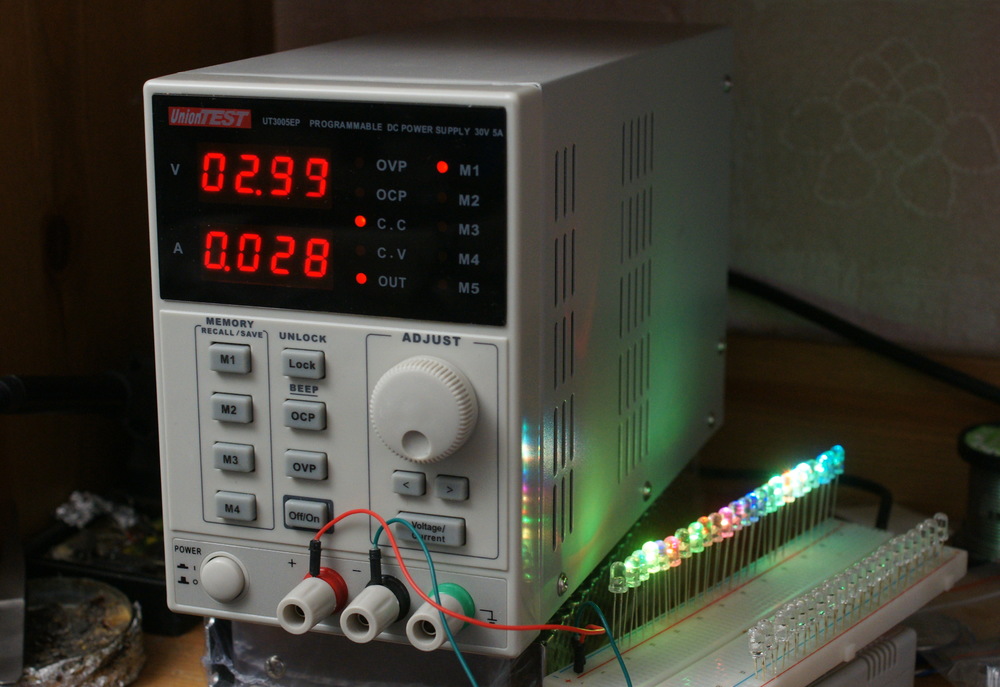
')
There are no complaints on the operation of the unit, the accuracy of the indicators without calibration is about 1-2% (you can calibrate to <0.5%, more on this below). You can save 5 presets settings, the first 4 buttons, 5th - is activated with the button M4 + wheel to the right. M5 settings are saved automatically.
Video reviews: the original eevblog of the old revision (with measurements, the fail-part is fixed), an overview of the changes to the revised revision .
The power supply is linear - it provides minimal noise, but requires a huge transformer. There are several high-current taps from the transformer - relyushki switch the transformer windings in the ranges of 0-7V, 7-14, 14-21, 21-31V. This is necessary in order to not dissipate too much power on the linear stabilizer for low voltages. For a circuit with 4 ranges - heat dissipation in the worst case is about 40 watts (5A * ~ 8V). There are also several low-current windings - bipolar power for the control circuit, and unipolar power for the interface board with a computer. The voltage is adjustable from zero - respectively, you can turn on 0.05V 5A :-)
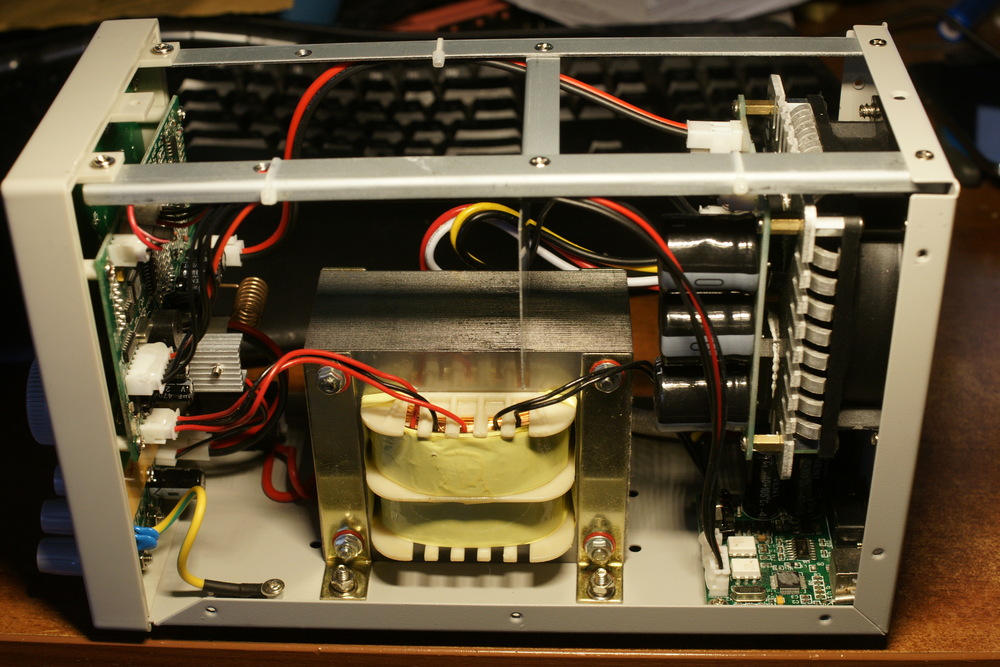
The diameter of the transformer winding wire inspires confidence:
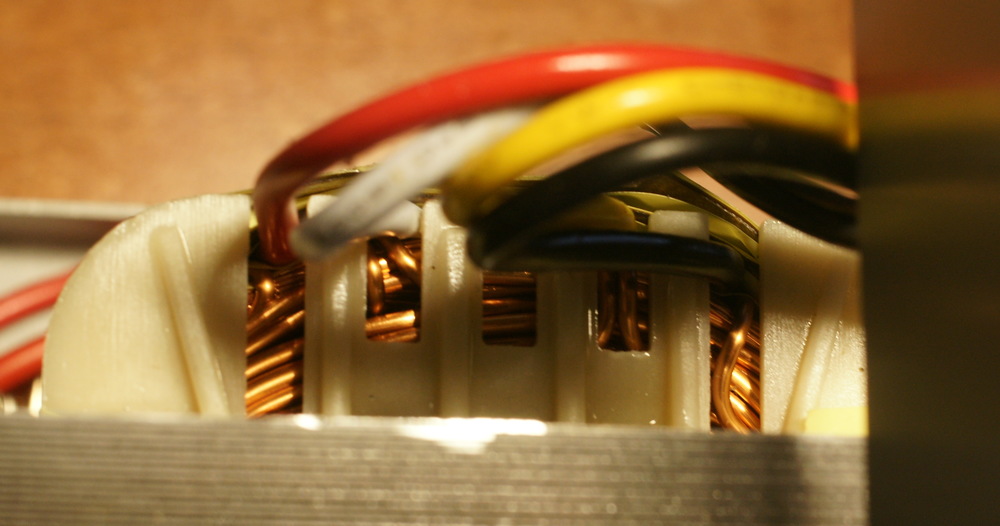
Fee power electronics. This is a new revision with a corrected overheating problem - it can easily withstand a short circuit and a current of 5A for a long time. The fan speed is controlled automatically depending on the calculated power output (and not temperature) - the fan increases the speed immediately after the “heavy mode” is turned on. At low load, it rotates slowly and is almost inaudible. Capacitors after the diode bridge - 3x2200 microfarads, voltage with a margin.

On the control board catches the eye 13 + 14 bit (current + voltage) R-2R DAC controlled by shift registers 74HC595.
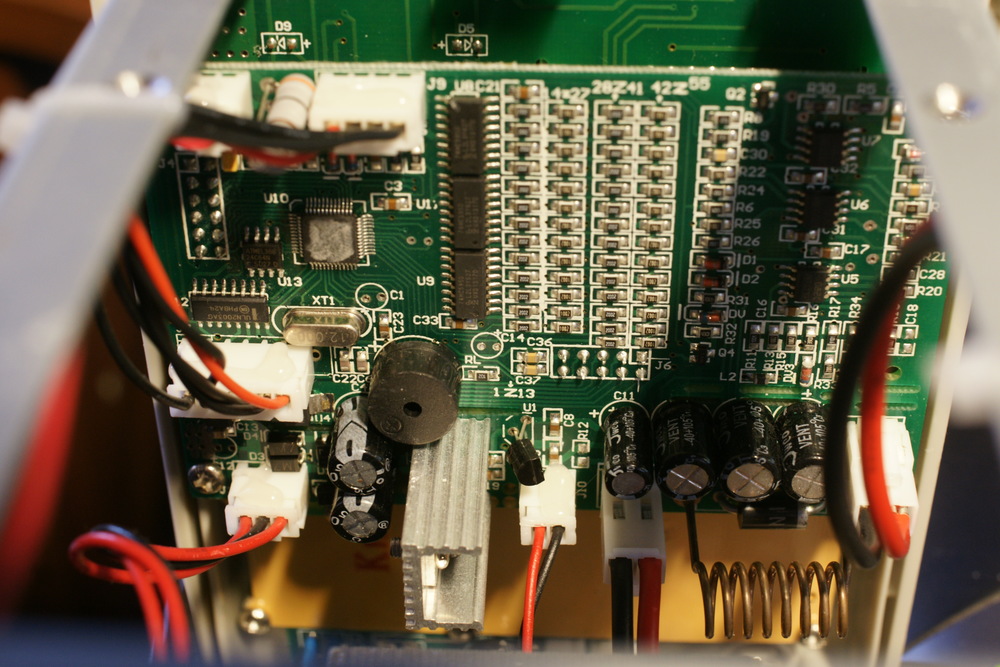
Communication board with a computer - with optoisolation + separate power supply with galvanic isolation. In the upper left of the board, an additional common mode filter is seen - another sign of a new revision of iron.

Conclusions allow connection in 3 ways - “wire into a hole and clamp”, “wire around and clamp”, insert a “banana” connector (banana-plug):
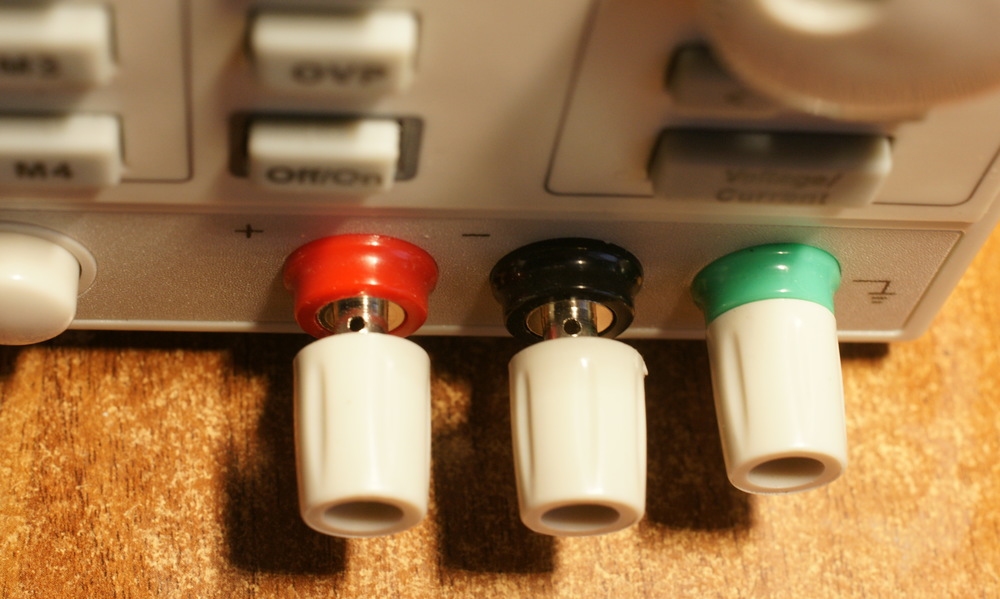
We calibrate a multimeter: To do this, we need an exact voltage source - I decided to quickly assemble it myself, based on the exact voltage source REF5050, which gives out 5V with an accuracy not worse than 0.1%. Since my multimeter has a maximum displayed value of 1999 - 5V will give a little accuracy. Therefore, I divide it 3 times by a resistor divider of 0.1% resistors (with averaging of 3 resistors) - and I get a voltage of 1.666V. Then you need to find a trimmer that adjusts the reference voltage inside the multimeter. In my case for Uni-T UT70A Google helped me.
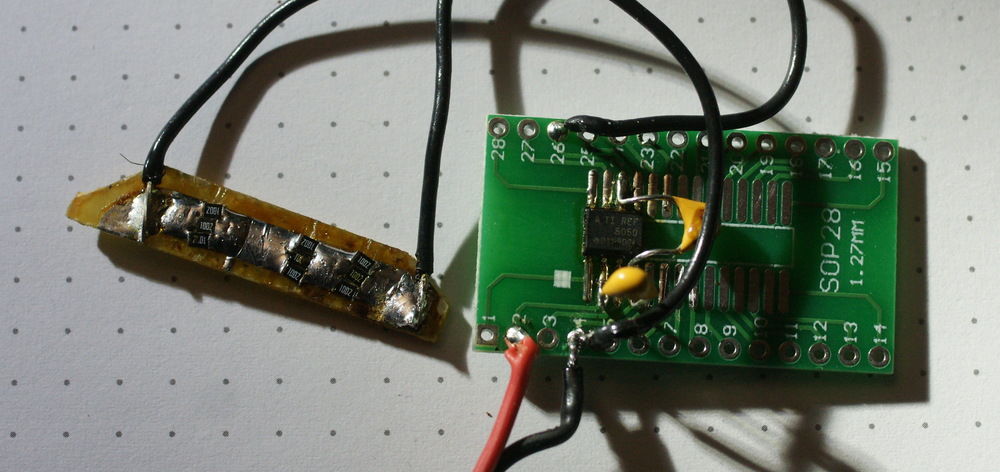
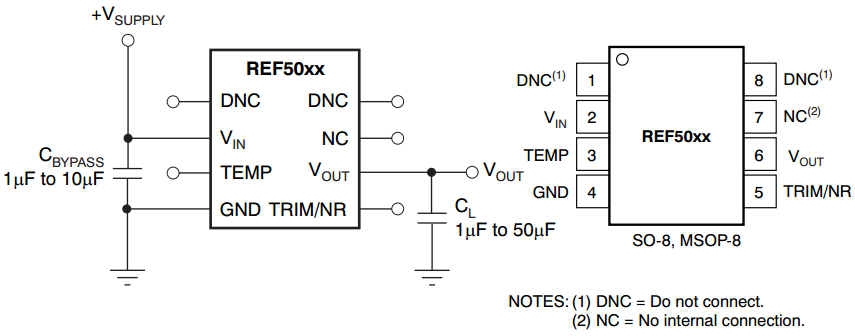
Calibrate the power supply: Turn on the device and wait for 2 minutes to warm up. Turn it off, and turn it on with the M4 button held down, then 4 stages of calibration:
1) 0 voltage: measure the voltage with a multimeter, and twist the wheel until it is as close as possible to zero. Click M1 to save. Click Voltage / Current for the next stage.
2) 0 current: turn the wheel until there is 0mA current, press M1 to save. Click M4 to go to the next step.
3) Maximum voltage: twist the wheel until the voltage is exactly 30V. Click M1 to save. Click Voltage / Current for the next stage.
4) Maximum current: turn the wheel until there is a current of 5A. Click M1 to save.
5) Turn the device off and on - calibration is complete.
If one of the steps does not save the result of the calibration, the device may then incorrectly show, in which case it will be necessary to repeat the calibration.
Ps. The block is a long time at maximum load in the imager (removed TRIO_Smartcal), the temperature is quite modest:

Update: Suddenly , the KORAD block came - an inspection of the viscera confirmed that there were no differences between them.
At first, out of habit, I ordered the unit directly from China, but it did not reach me (the money was returned) - and then I saw that they were selling UnionTest in Moscow stores at about the same price (5210 rubles for this model) - at first glance KORAD with a different name. However, the question remains, do they not accidentally sell the old revision of iron there? I bought the block, and now we'll take a look at the insides. Looking ahead - a new revision.

')
There are no complaints on the operation of the unit, the accuracy of the indicators without calibration is about 1-2% (you can calibrate to <0.5%, more on this below). You can save 5 presets settings, the first 4 buttons, 5th - is activated with the button M4 + wheel to the right. M5 settings are saved automatically.
Video reviews: the original eevblog of the old revision (with measurements, the fail-part is fixed), an overview of the changes to the revised revision .
The power supply is linear - it provides minimal noise, but requires a huge transformer. There are several high-current taps from the transformer - relyushki switch the transformer windings in the ranges of 0-7V, 7-14, 14-21, 21-31V. This is necessary in order to not dissipate too much power on the linear stabilizer for low voltages. For a circuit with 4 ranges - heat dissipation in the worst case is about 40 watts (5A * ~ 8V). There are also several low-current windings - bipolar power for the control circuit, and unipolar power for the interface board with a computer. The voltage is adjustable from zero - respectively, you can turn on 0.05V 5A :-)

The diameter of the transformer winding wire inspires confidence:

Fee power electronics. This is a new revision with a corrected overheating problem - it can easily withstand a short circuit and a current of 5A for a long time. The fan speed is controlled automatically depending on the calculated power output (and not temperature) - the fan increases the speed immediately after the “heavy mode” is turned on. At low load, it rotates slowly and is almost inaudible. Capacitors after the diode bridge - 3x2200 microfarads, voltage with a margin.

On the control board catches the eye 13 + 14 bit (current + voltage) R-2R DAC controlled by shift registers 74HC595.

Communication board with a computer - with optoisolation + separate power supply with galvanic isolation. In the upper left of the board, an additional common mode filter is seen - another sign of a new revision of iron.

Conclusions allow connection in 3 ways - “wire into a hole and clamp”, “wire around and clamp”, insert a “banana” connector (banana-plug):

Remote control
Computer communication module - increases the cost by ~ 650 rubles. You can control both via USB and RS232, there is a control program for Windows. The control protocol is known, so you can, for example, do some kind of automatic tests, even controlling the unit from the microcontroller. You can see the measurement results of the current / voltage. COM port settings: 9600-8-N. The commands are as follows:The end of line character (Enter) is not needed. Also, the power supply does not return echo commands (in the terminal you will not see what you are typing).VSET1: 1.20 ISET1: 0.25 Iset1? VSET1? IOUT1? VOUT1? * Idn? OCP0 / OCP1 OVP0 / OVP1 OUT0 / OUT1 STATUS?
Calibration
Naturally, getting the right 4 significant digits for current / voltage is not easy and will require calibration. The “out of the box” block was about 1-2% wrong. Before you calibrate the power supply - you need to calibrate the multimeter, if it cost less than $ 100 - it can easily have an error greater than 1%.We calibrate a multimeter: To do this, we need an exact voltage source - I decided to quickly assemble it myself, based on the exact voltage source REF5050, which gives out 5V with an accuracy not worse than 0.1%. Since my multimeter has a maximum displayed value of 1999 - 5V will give a little accuracy. Therefore, I divide it 3 times by a resistor divider of 0.1% resistors (with averaging of 3 resistors) - and I get a voltage of 1.666V. Then you need to find a trimmer that adjusts the reference voltage inside the multimeter. In my case for Uni-T UT70A Google helped me.


Calibrate the power supply: Turn on the device and wait for 2 minutes to warm up. Turn it off, and turn it on with the M4 button held down, then 4 stages of calibration:
1) 0 voltage: measure the voltage with a multimeter, and twist the wheel until it is as close as possible to zero. Click M1 to save. Click Voltage / Current for the next stage.
2) 0 current: turn the wheel until there is 0mA current, press M1 to save. Click M4 to go to the next step.
3) Maximum voltage: twist the wheel until the voltage is exactly 30V. Click M1 to save. Click Voltage / Current for the next stage.
4) Maximum current: turn the wheel until there is a current of 5A. Click M1 to save.
5) Turn the device off and on - calibration is complete.
If one of the steps does not save the result of the calibration, the device may then incorrectly show, in which case it will be necessary to repeat the calibration.
Summary
For my money (~ 5,210 rubles already in Moscow), given the availability of digital calibration, a well-known control protocol and resolved childhood diseases - more than an excellent device, almost without competition.Ps. The block is a long time at maximum load in the imager (removed TRIO_Smartcal), the temperature is quite modest:

Update: Suddenly , the KORAD block came - an inspection of the viscera confirmed that there were no differences between them.
Source: https://habr.com/ru/post/213233/
All Articles